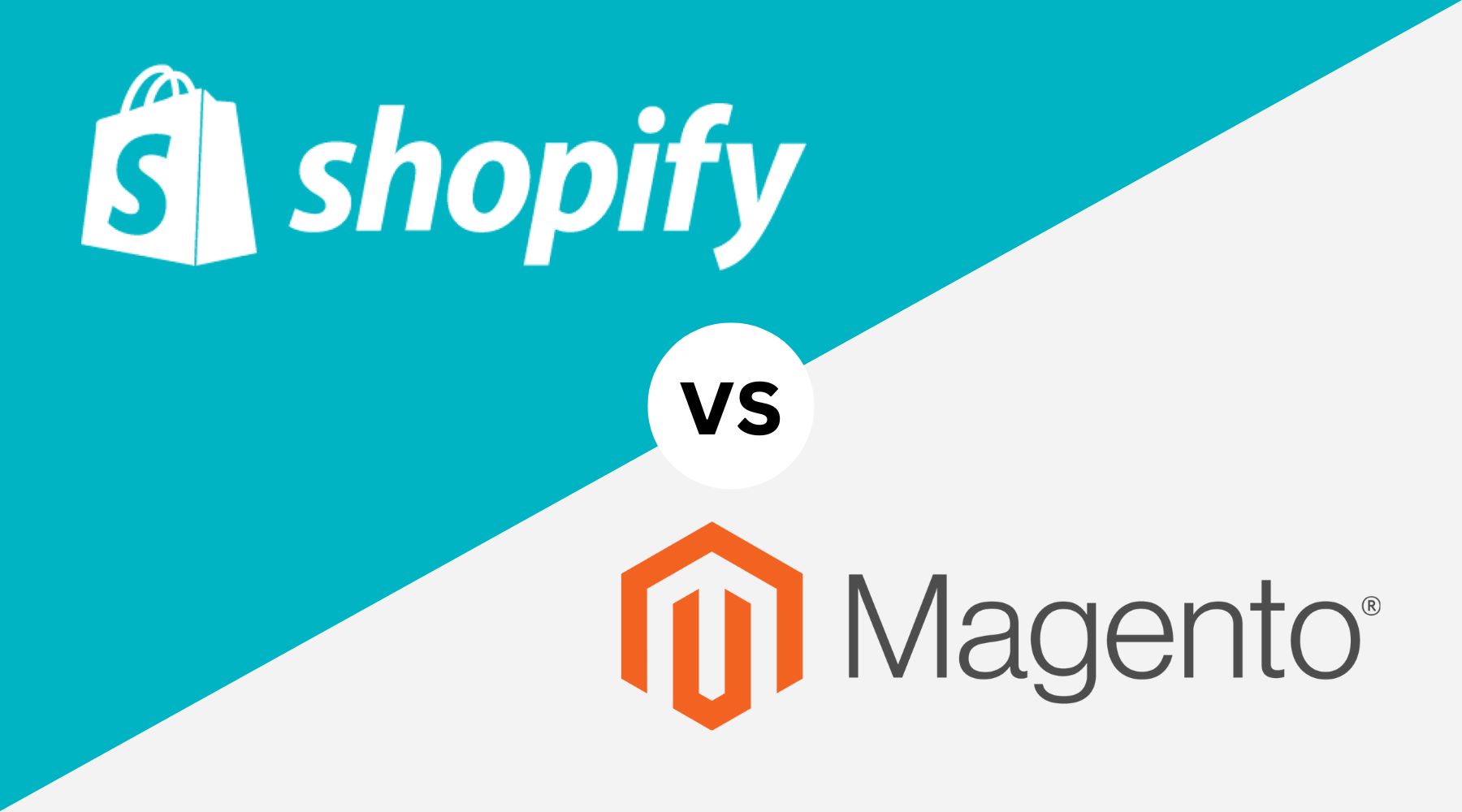If you want to build an online store or modernize your existing platform, two systems are particularly common to choose from: an open-source solution with maximum control or a cloud model that focuses on ease of use and scalability.
Magento and Shopify are among the most established e-commerce platforms worldwide. However, they pursue different approaches that can significantly impact your daily work, maintenance, integrations, and growth.
This is exactly where this comparison comes in : You'll find out which system is a better fit for your business model. We'll examine the technical, strategic, and operational features of both shop systems.
The decision between a customizable setup and a low-maintenance, complete solution affects not only developers, but also you as a decision-maker in the business context.
If you've already taken a closer look at the technical side, this article about the difference between Shopify Plus and Magento might also be of interest to you.
What is the fundamental difference between Shopify and Magento?
Both systems are among the most important solutions in digital commerce. However, they are based on completely different principles. If you're currently in the process of finding the right platform for your business, it's worth taking a closer look at these differences.
Shopify is based on the principle "Software as a Service " (SaaS). You work in a cloud-based system where hosting, maintenance, security, and technical infrastructure are all handled by the provider. You can get started right away, without your own servers or complex setup.
Updates run automatically in the background, and new features can be easily added via the integrated app store.
This keeps your focus on what matters : performance, growth and conversion.
Magento, now known as Adobe Commerce, pursues a Open source approach . Here, you get full access to the source code and can customize every function in the system. This provides maximum flexibility, but also requires technical know-how or an experienced development team.
You are responsible for hosting, security measures, maintenance, and extension compatibility. For many companies, this means more freedom, but also more effort.
The target groups of the two systems differ accordingly. Shopify is primarily aimed at high-growth DTC brands , fast-moving mid-sized companies and omnichannel retailers that rely on easy scalability and short time-to-market cycles.
Magento/Adobe Commerce, on the other hand, is used by corporations, B2B providers, and highly specialized online retailers. It is useful wherever processes, pricing logic, or integrations deviate significantly from the standard.
A look at market trends shows that many companies start with complex on-premises solutions and later switch to cloud-based platforms. The reason lies in the combination of lower maintenance burden, technical predictability, and faster development.
Anyone who wants to grow with a platform should therefore pay attention not only to features, but also to the overall package of operating costs, update strategy and internal resource utilization.
An overview of the most important Shopify Plus benefits can help you better understand the scaling perspective.

Direct comparison: SaaS vs. open source in e-commerce
|
criterion |
SaaS model (e.g. Shopify) |
Open source (e.g. Magento/Adobe Commerce) |
|
Hosting |
Inclusive, managed by the provider |
Self-responsible or external |
|
Maintenance & Updates |
Automatically and regularly |
Manually by developers |
|
Access to the source code |
Restricted |
Complete |
|
Start-up effort |
Low – immediately usable |
High – technical setup required |
|
Scaling |
Easy adjustment via tariffs |
Individual with technical effort |
|
Design & Templates |
Selection of tested themes |
Flexible, but more complex |
|
Extensions |
App ecosystem, high compatibility |
Many plugins, some unstable |
|
Technical know-how |
Not required |
Absolutely necessary |
|
Target groups |
Brands with a focus on time-to-market |
Companies with complex requirements |
|
Total Cost of Ownership |
Plannable and monthly calculable |
Variable, depending on setup and maintenance |
1. Drag-and-drop vs. developer focus: What to expect in everyday use
Simplicity is a key factor when choosing your e-commerce system especially if your team is made up of marketing, product, or content managers rather than developers. An intuitive platform not only saves time but also reduces ongoing costs for external support or internal training.
Your daily work in the backend determines how efficiently you can create products, launch campaigns, or update content.
That’s why it’s worth taking a closer look at the differences:
|
function |
Shopify |
Magento |
|
Furnishings |
In a few minutes |
Technical setup with hosting & configuration required |
|
user interface |
Visual, logically structured |
Partly nested, technology-heavy |
|
Changes in layout |
Drag and drop in the theme editor |
Adjustments mostly in the code |
|
Training effort |
Low, ready to use |
High, especially in complex setups |
|
Error susceptibility |
Low thanks to clear UI |
Higher through manual intervention |
|
Multilingualism |
Integrated, easy to set up |
Possible, but involves effort |
If you want to build a store that your team can maintain and develop on their own, a low-threshold approach is essential. Shopify uses a graphical user interface that lets you adjust content and layouts without any coding skills.
You work directly in a live preview and can test changes in real time without risking system stability.
Adobe’s open-source solution, on the other hand, gives you maximum control but also maximum responsibility. Even small layout changes, such as adding a new CTA section or modifying product grids, require:
- Templates,
- Child themes or
- even interventions in the core system.
This means: that without technical expertise or a dedicated development team, you will quickly run into limitations.
For teams that need to react quickly to campaigns or seasonal shifts, an intuitive interface is extremely valuable. No waiting times, no tickets, no team meetings just to approve code changes.
If you need help with your setup, a specialized Shopify Plus development agency can support you in tailoring the system to your exact requirements.

2. Flexibility and customization – how deeply you can adapt your system
Customization is more than a design feature. It determines how well your shop system fits your internal workflows.
Whether it’s special B2B pricing, a multi-step ordering process, or custom product logic the more specific your business model is, the more flexible your system needs to be.
Adobe Commerce (Magento) is built around maximum technical freedom.
You get full access to the source code and can adjust virtually every line:
- You want a multi-step order process, for example with internal sales approval?
- You need a role and permissions structure for large customers?
- Or you want to completely restructure the checkout?
With the open-source solution, all of this is possible as long as you have an in-house development team or work with a specialized agency.
The trade-off: every adjustment requires project management, code reviews, testing, and ongoing maintenance. The more complex your processes are, the more your shop depends on code quality and system stability.
Many B2B companies use this flexibility because they need to deeply integrate existing ERP systems or custom logic.
Shopify Plus takes a different approach. You work within a stable framework in which many requirements can be implemented through the App Store or API.
- Design changes are possible through the theme structure, including custom code.
- The checkout can be fully customized in the Plus plan for example, for B2B logic or additional form fields.
- With Shopify Functions and metafields, you can add your own business logic without leaving the platform.
This means: you don’t need a full development team. You work efficiently with what the system provides natively. Customizations are faster to implement, easier to maintain, and often come with lower ongoing costs.
Overview: Magento vs Shopify
|
aspect |
Shopify Plus |
Adobe Commerce |
|
Source code access |
Partially (theme and checkout files) |
Completely open |
|
Complex business logic |
Via APIs, apps or Shopify Functions |
Customizable directly in the core |
|
Checkout modification |
Available from Shopify Plus |
Unrestrictedly possible |
|
Maintenance effort after updates |
Small amount |
High in individual adjustments |
|
Time-to-market for features |
Briefly through the app ecosystem |
Long through in-house development |
If you want maximum control, Adobe Commerce is the right choice but you must plan for ongoing development resources, security concepts, and continuous update management.
If speed, efficiency, and predictability matter more to you, a professional Shopify Plus Development Service gives you far more flexibility without letting complexity get out of hand.

3. Extensions & Integrations – App Store or Developer Marketplace?
Your online store isn't a standalone system, but part of a networked infrastructure. For everything to run smoothly, different tools and services must work together seamlessly.
This includes:
- Payment providers such as PayPal or Klarna
- Shipping service providers such as DHL or Sendcloud
- CRM and marketing tools such as HubSpot or Klaviyo
- Accounting software such as Lexoffice or sevDesk
- ERP systems such as Xentral, Plentymarkets or SAP
The key question is : How easily and reliably can these systems be integrated? And this is precisely where the differences between the two platforms become particularly clear.
This is where the two systems differ fundamentally:
|
criterion |
Shopify |
Magento (Adobe Commerce) |
|
Number of extensions |
Over 8,000 verified apps in the official store |
Around 4,000 in the Marketplace |
|
compatibility |
High quality standards, regular updates |
Different – often version problems |
|
Integration effort |
Low through plug-and-play |
Often in-house development required |
|
API documentation |
Uniform, standardized |
Very different depending on the provider |
|
Maintenance effort |
Centralized, often with support |
Depends on developer or agency |
Shopify: App ecosystem with a focus on usability
Shopify follows the app store approach: extensions can be installed with a click, are compatible with the core system, and are often ready to use within minutes.
Typical examples:
- Klaviyo for email marketing
- Sendcloud for shipping processing
- Xentral or PlentyMarkets as an ERP system
- Lexoffice or sevDesk for accounting
Most of these tools have their own support teams, clear user guides, and automatic updates. You don't have to worry about maintaining the interfaces, as the providers take care of that.
This level of standardization is a huge advantage, especially for fast-growing brands: fewer bugs, less downtime, less technical overhead.
Magento/Adobe Commerce: Maximum openness, but higher effort
Magento technically allows for anything. You can build or customize any integration yourself.
This offers maximum flexibility, but also brings with it significantly more responsibility:
- Many extensions come from third parties with different standards
- Not all plugins are compatible with every version
- Updates to the shop software can cause conflicts with existing modules
- Troubleshooting and debugging are complex and time-consuming
In addition, external systems often have to be connected via custom-developed interfaces. This is feasible, but costly and maintenance-intensive.
4. Security, Updates & Maintenance
Security affects not only hosting but also payment processing, data encryption, and system maintenance.
Shopify offers you:
- Automatic updates
- SSL certificates from the start
- PCI-DSS compliant checkout processes
- No maintenance required by your team
Magento requires you to:
- Manual updates & patches
- Setting up SSL certificates
- Maintenance of own servers or hosting providers
- High security requirements in day-to-day business
If you don't have your own IT team, the SaaS model offers a clear advantage. You work with a system that protects itself, thus freeing you up.
That's why many brands rely on a specialized Shopify Plus agency for security and maintenance.

5. Scalability – which platform grows with you more effectively?
As your online business expands, it’s not just your inventory, team, and marketing that need to keep up your shop system must not become a bottleneck.
Whether you’re reaching new target audiences, entering international markets, or significantly expanding your product range, the technical foundation determines whether your growth runs smoothly or whether you constantly need to make adjustments.
This is about more than just server capacity.
Scaling affects:
- System stability during traffic peaks (e.g. TV advertising or Black Friday)
- Multi-store capability for international domains, languages or brands
- Extensibility in catalog size, user roles or authorizations
- performance despite growing data volumes
- Time to market when introducing new features
Here is an overview of the most important differences :
|
Scaling factor |
Shopify Plus |
Adobe Commerce Cloud |
|
Multi-Store |
Possible via Shopify Markets or Expansion Stores |
Standard function, but complex to set up |
|
Headless architecture |
API-based, high-performance |
Flexible, requires configuration |
|
Enterprise features |
Integrated with Shopify Plus |
Modular via paid add-ons |
|
Traffic peaks |
Automatically scalable (CDN, Cloud) |
Hosting dependent, sometimes manual tuning necessary |
|
Performance monitoring |
Integrated |
Third party required |
Shopify Plus: Scaling without system friction
Shopify is built to grow alongside your business whether you’re starting out with a handful of products or already generating seven-figure revenue. Thanks to its cloud-based infrastructure, you don’t need to worry about server capacity, storage, or page speed.
You benefit from automatic scaling during traffic peaks and can launch new regions using Shopify Markets or Expansion Stores with minimal effort.
Headless setups, custom apps, and proprietary integrations can be added without compromising system stability. Even businesses operating across multiple countries, currencies, and fulfillment partners manage everything centrally through a scalable architecture.
Magento / Adobe Commerce: Scalability that comes with technical depth
Magento is designed for large-scale commerce. You can run as many store views, currencies, and B2B channels as needed, configure hosting freely, and scale almost every part of the system.
However, this requires an experienced DevOps team or an agency with enterprise-level expertise. Without these resources, the maintenance effort increases with every growth phase.
For multinational setups, Adobe Commerce gives you deeper control over pricing logic, tax configurations, and shipping zones but only if you’re prepared to handle the corresponding technical overhead.
If you're looking for a platform that enables rapid growth with minimal technical risk, Shopify Plus is the more suitable choice. You operate within a stable environment that can be extended with just a few clicks.
You can find a detailed comparison of Shopify plans here: Shopify Advanced vs Shopify Plus.
6. SEO & Marketing
Search engine optimization begins with the setup of your store. The platform determines your visibility.
Shopify offers:
- Customizable meta tags, URLs, image alt texts
- Loading time optimization
- Integrated marketing tools
- Apps for SEO, newsletters, retargeting
Magento offers:
- In-depth SEO configuration in the backend
- High technical control
- Expandable marketing modules
- Content management more flexible, but more complex
Shopify is SEO-ready right out of the box. Adobe Commerce requires more expertise, but offers more technical flexibility.
Also interesting in context: WooCommerce vs Shopify.

7. Multichannel & POS – Online meets offline
Customers today expect far more than a functional online store. They discover products on social media, buy through marketplaces, browse via Google Shopping, or stand inside a physical store scanning a QR code.
A modern commerce shop system must not only support these channels it needs to connect, synchronize, and centrally manage them.
These requirements can only be met efficiently if your system is not just compatible with multichannel and point-of-sale (POS) workflows, but actively designed to support them at scale.
|
Channel / Function |
Shopify POS & Multichannel |
Adobe Commerce with third parties |
|
Social Commerce |
Natively integrated (Instagram, Facebook, TikTok) |
Extensible, but plugin dependent |
|
Marketplaces |
Connection to eBay, Amazon & Co. with just a few clicks |
Additional modules and manual configuration |
|
POS systems |
Shopify POS as your own POS solution (including hardware) |
Third-party providers required, e.g., via ERP connection |
|
Central data synchronization |
In real time across all channels |
Partly manually or with middleware |
|
Customer data |
Managed consistently in the Shopify backend |
Fragmented without additional tools |
Shopify
Shopify was built from the ground up with omnichannel commerce in mind. The platform offers native integrations with key sales channels such as Instagram, Facebook, Pinterest, TikTok, Google Shopping, and Amazon. New channels can be activated directly from the backend without additional setup overhead.
One standout feature is Shopify POS a fully integrated point-of-sale system for brick-and-mortar retail, trade shows, or pop-up stores. It seamlessly syncs inventory, orders, and customer data across all channels, giving you a unified view of your business.
With this central system you manage
- stocks,
- payments,
- Returns and
- Customer profiles
Data synchronization occurs in real time, ensuring your inventory and sales figures remain consistent at all times.
Magento/Adobe Commerce
Magento can support multichannel commerce as well, but only through third-party tools, plugins, or custom-built integrations. Connecting social commerce platforms or marketplaces is technically possible, yet it typically requires individual configuration, continuous maintenance, and a well-structured data management setup.
For in-store sales, there is no native POS solution. You have to rely on external providers and connect them via API or middleware, which increases system complexity and introduces additional points of failure in data synchronization.
If you're exploring alternatives, this comparison may also be useful: Shopware vs Shopify.
8. B2B functionalities
If you want to serve business customers, features like tiered pricing, customer groups, and approval workflows are mandatory.
Adobe Commerce (Magento):
- Native B2B Suite
- Customer-specific price lists
- Offer function and rights management
- Flexible for complex logic
Shopify Plus:
- B2B extension in the Enterprise plan
- Customer groups, net prices, volume discounts
- API-first approach to ERP integration
- Still under development, but with a clear roadmap
If B2B conversion is your topic: Shopify Plus CRO Services.

9. Costs & Pricing Structure – What does each platform truly cost?
What starts out inexpensive can become costly in the long run. That’s why it’s worth taking a closer look at the total cost of ownership.
|
Cost factor |
Shopify |
Magento |
|
Entry fee |
from 36 €/month |
Open source: free, but setup required |
|
Hosting |
including |
separately |
|
maintenance |
including |
Agency or IT team required |
|
Extensions |
mostly cheap apps |
often expensive modules |
|
Enterprise version |
from approx. €2,000/month |
from €22,000/year |
You can find out more about positioning here: Zoey vs Shopify Plus.
10. Performance & Loading Speed – Which platform is faster?
Loading time has a direct impact on your conversion rate, and it depends heavily on the system.
Shopify:
- CDN-supported infrastructure
- Global server structure
- Mobile performance optimized
- Automatic compression & caching
Magento:
- Performance depends on hosting
- Optimization via third-party tools
- Strong performance with good infrastructure
- Caching can be individually configured
You can find out what this looks like in the enterprise sector here: Scayle vs Shopify Plus.
Shopify vs. Magento at a glance
|
criterion |
Shopify Plus |
Adobe Commerce (Magento) |
|
System type |
SaaS (cloud-based) |
Open Source / On-Prem / Cloud |
|
Furnishings |
Fast, without prior technical knowledge |
Complex, developer required |
|
user interface |
Intuitive, visual |
Technically demanding |
|
Design customization |
Themes, Liquid code, drag and drop |
Free code, full template control |
|
Checkout customization |
Fully customizable only in the Plus plan |
Freely customizable |
|
Extensions |
>8,000 verified apps in the App Store |
>4,000 extensions, varying quality |
|
Multichannel & POS |
Natively integrated, including own POS |
Third-party provider required |
|
B2B functionalities |
Available in the Plus plan, solid basis |
Very comprehensive, especially for complex use cases |
|
SEO & Marketing |
Controllable directly in the backend & via apps |
Highly customizable, but technically complex |
|
Scaling |
Automatic, high-performance |
Possible, but depends on setup & hosting |
|
Cost structure |
Transparent, from 36 €/month, Plus from approx. 2,000 € |
Open source free, Enterprise from approx. €22,000 |
|
Maintenance & Updates |
Including |
Self-responsible |
|
Support |
24/7 support, large community |
Community Forum + Enterprise Support |
Decision guide: Which system fits your goals?
If you’re looking for an e-commerce platform that supports rapid growth, keeps technical complexity low, and offers as many native features as possible, Shopify Plus is the more efficient choice. You focus on your business while the platform handles infrastructure, hosting, and security.
Shopify Plus is ideal for:
- DTC brands with a focus on conversion and time-to-market
- Medium-sized merchants with clear defined processes
- Companies expanding into international markets, multichannel, or POS
Adobe Commerce (Magento) is best suited when you need a heavily customized setup, deep integration with existing IT systems, or complex B2B processes and you’re willing to invest in development, maintenance, and technical operations.
Adobe Commerce is a strong fit for::
- Enterprises with specialized pricing or role-based logic
- Wholesalers with quotation workflows and customer-specific catalogs
- Projects that cannot be mapped with standard processes
If you’re still unsure, the next section on migration will help especially if you're currently using Magento and considering a switch.
For those who want to dive deeper
Companies with modular architectures and API-first approaches may find our comparison of Commercetools vs Shopify particularly useful. It explains how composability and scalability play out in real-world setups.
If your business sells creative goods, one-of-a-kind items or limited editions, you might be comparing platforms like Etsy and Shopify. Our article Shopify vs Etsy shows where the differences really matter fees, target audiences, and branding.
Existing ERP environments also influence the choice: Businesses prioritizing backend integration and process automation should take a closer look at Shopify Plus vs NetSuite.
For larger teams focused on enterprise-level scaling, deep API access and flexible pricing models, our comparison Shopify Plus vs BigCommerce Enterprise provides a practical breakdown.
If you’ve reviewed your options and want support with decision-making or implementation, we’re here to help.








